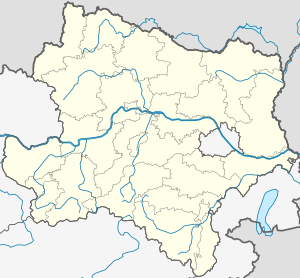Hydroelectric power station Neubruck
| Hydroelectric power station Neubruck | ||
|---|---|---|
| Hydroelectric power station Neubruck (seen from the north) | ||
| location | ||
|
|
||
| Coordinates | 47 ° 58 '32 " N , 15 ° 10' 38" E | |
| country | Austria - Lower Austria | |
| place | Scheibbs | |
| Waters | Erlauf (river) | |
| power plant | ||
| owner | Ökowind Renewable Energy Generation GmbH | |
| operator | Ökowind Renewable Energy Generation GmbH | |
| Start of planning | 2006 | |
| construction time | 2009-2010 | |
| Start of operation | 2010 | |
| technology | ||
| Bottleneck performance | 1.2 megawatts | |
| Average height of fall |
8.7 m | |
| Expansion flow | 16 m³ / s | |
| Standard work capacity | 5.3 million kWh / year | |
| Turbines | 1 Kaplan bulb turbine | |
| Generators | 1 synchronous generator | |
| Others | ||
| was standing | September 2011 | |
The hydropower plant Neubruck is a run-of- river power plant on the Große Erlauf in the Austrian state of Lower Austria . The power plant is located in the community of Scheibbs in the district of Neubruck.
location
The newly built powerhouse is right next to Erlauftal Straße (B25) and the Erlauftalbahn . Before that, the turbine was in the factory halls of the former Töpperwerk of Andreas Töpper , the former iron and rolling mill in Neubruck, which later became a paper mill.
history
The small, now rather inconspicuous Lower Austrian village of Neubruck, located on the river Erlauf and the now heavily trafficked federal highway 25, was once a neuralgic point in a region that was an essential part of Austrian economic and industrial history for centuries until the end of the 19th century: the Austrian iron road , also called "Eisenwurzen". This industrial region, which in the preliminary phase of industrialization operated far beyond the national borders and exported iron and steel products up and down the Danube, had developed extremely complex organizational structures, which for a long time brought a lot of prosperity to an entire region. The new small hydropower plant is at a historically significant location: a place where hydropower has played a major, indeed central, role since it was founded. The almost 200-year history of Neubruck symbolizes the rise and fall of an industrial complex, which in its heyday, in the first half of the 19th century, became a model company of the Kuk monarchy . The Eisen- und Stahlwerk Neubruck, founded by Andreas Töpper at the beginning of the 19th century, represents an important phase of industrialization in Austria, in which the iron industry, which until then had functioned in countless small units under the name of the small iron industry , became medium-sized Combined units in order to be able to use the new technologies and production methods required by the rapidly advancing industrialization. Here in Neubruck you can still "read" the industrial revolution, which also swept across the rural areas and in almost 100 years triggered structural changes that changed the entire cultural area of the Eisenwurzen lastingly.
In 2009 Ökowind Erneuerbare Energieproduktion GmbH started building this small hydropower plant . The power plant was completed after about a year of construction. The building was a complete replacement instead of the original wooden weir. The power plant has been producing electricity since June 2010 and feeding it into the public grid.
technical description
In the place of the newly built hydroelectric power station, there was previously a wooden weir with a discharge channel into the former paper mill in Neubruck. A modern and more efficient power plant has now taken its place. The bottom outlet now enables attachments to be easily passed through. In addition, a near-natural fish pass was built which is exemplary for other power plants.
construction
The first excavation work began in October 2009 and shortly afterwards the Erlauf (river) was diverted. The power plant went into operation in June 2010. The power plant was built completely in the dry and the Erlauf was diverted during the entire construction period.
ecology
Great importance was attached to ecological measures and a state-of-the-art fish pass was built.
architecture
Great attention was paid to the architecture and visitor friendliness of this power plant. Julia Taubinger was the architect of the power plant and used this opportunity to write her thesis on the power plant.
bibliography
- ↑ Julia Taubinger: The role of architecture as a mediator between renewable energy solutions and humans. The small hydropower plant in Neubruck. Thesis. 2009
- ↑ ÖKOWind: Company presence 2012



